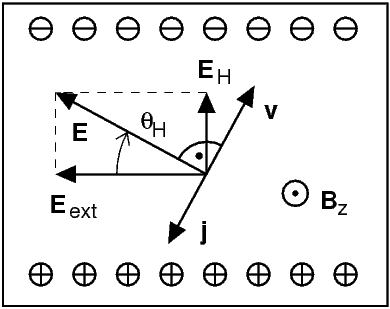Hall angle
The Hall angle is a characteristic angle in the Hall effect between the external electric field and the total field , where the Hall field is.
theory
The definition of the Hall angle is based on the following conditions illustrated in the illustration on the right: The magnetic field is perpendicular to the conductive layer . In the plane of the layer, the electric field prevails , which is generated by an externally applied voltage and which here points in the negative direction without loss of generality . In order to be able to assume homogeneous current densities and fields, it is assumed that the sample is much wider than it is high. Furthermore, the representation is limited to electrons . The concentration of charge carriers at the edges of the sample creates the Hall field , which counteracts the drift of the electrons caused by the Lorentz force . The drift speed of the centers of rotation of the electrons moving on spirals is perpendicular to the total field . The current density is then exactly opposite to the drift speed because of the negative charge of the electrons.
The following applies to the Hall angle:
- .
It was used here that applies to the Hall field and that the drift speed in the direction is determined by the mobility and the external electric field , namely according to the relationship .
Without a magnetic field ( ) the Hall field disappears and the total field coincides with the external field ( ). For a finite magnetic field with the total field rotates with a negative angle of rotation (i.e. clockwise ) from the horizontal .
Experimental investigation
In short, wide samples, the Hall angle could be photographed directly in photoluminescence images by tilting current filaments in high-purity semiconductor layers.





















